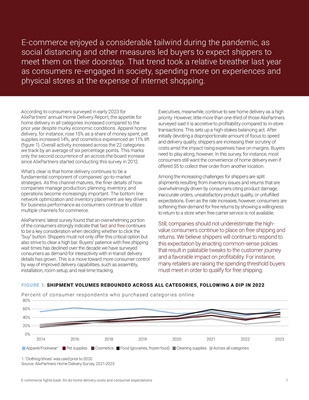
E-commerce fights back: So do home delivery costs and consumer expectations 2
E-commerce enjoyed a considerable tailwind during the pandemic, as
social distancing and other measures led buyers to expect shippers to
meet them on their doorstep. That trend took a relative breather last year
as consumers re-engaged in society, spending more on experiences and
physical stores at the expense of internet shopping.
According to consumers surveyed in early 2023 for
AlixPartners' annual Home Delivery Report, the appetite for
home delivery in all categories increased compared to the
prior year despite murky economic conditions. Apparel home
delivery, for instance, rose 15% as a share of money spent; pet
supplies increased 14%; and cosmetics experienced an 11% lift
(figure 1). Overall activity increased across the 22 categories
we track by an average of six percentage points. This marks
only the second occurrence of an across-the-board increase
since AlixPartners started conducting this survey in 2014.
What's clear is that home delivery continues to be a
fundamental component of companies' go-to-market
strategies. As this channel matures, the finer details of how
companies manage production, planning, inventory, and
operations become increasingly important. The bottom line:
network optimization and inventory placement are key drivers
for business performance as consumers continue to utilize
multiple channels for commerce.
AlixPartners' latest survey found that an overwhelming portion
of the consumers strongly indicate that fast and free continues
to be a key consideration when deciding whether to click the
"buy" button. Shippers must not only offer this critical option but
also strive to clear a high bar. Buyers' patience with free shipping
wait times has declined over the decade we have surveyed
consumers as demand for interactivity with in-transit delivery
details has grown. This is a move toward more consumer control
by way of improved delivery capabilities, such as assembly,
installation, room setup, and real-time tracking.
Executives, meanwhile, continue to see home delivery as a high
priority. However, little more than one-third of those AlixPartners
surveyed said it is accretive to profitability compared to in-store
transactions. This sets up a high-stakes balancing act. After
initially devoting a disproportionate amount of focus to speed
and delivery quality, shippers are increasing their scrutiny of
costs amid the impact rising expenses have on margins. Buyers
need to play along, however. In this survey, for instance, most
consumers still want the convenience of home delivery even if
offered $5 to collect their order from another location.
Among the increasing challenges for shippers are split
shipments resulting from inventory issues and returns that are
overwhelmingly driven by consumers citing product damage,
inaccurate orders, unsatisfactory product quality, or unfulfilled
expectations. Even as the rate increases, however, consumers are
softening their demand for free returns by showing a willingness
to return to a store when free carrier service is not available.
Still, companies should not underestimate the highvalue
consumers continue to place on free shipping and
returns. We believe shippers will continue to respond to
this expectation by enacting common-sense policies
that result in palatable tweaks to the customer journey
and a favorable impact on profitability. For instance,
many retailers are raising the spending threshold buyers
must meet in order to qualify for free shipping.
FIGURE 1: SHIPMENT VOLUMES REBOUNDED ACROSS ALL CATEGORIES, FOLLOWING A DIP IN 2022
Percent of consumer respondents who purchased categories online
1. 'Clothing/shoes' was used prior to 2020
Source: AlixPartners Home Delivery Survey, 2021-2023
Apparel/Footwear¹ Pet supplies Cosmetics Food (groceries, frozen food) Cleaning supplies Across all categories
80%
40%
0%
60%
20%
2014 2016 2018 2019 2020 2021 2022 2023